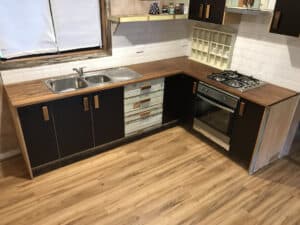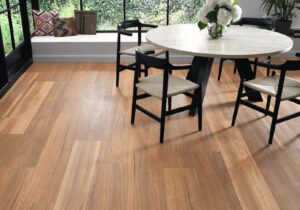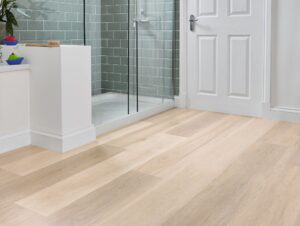If you are looking at getting a new floor and wish to save money by installing it yourself, then you would be after the easiest to install flooring. There are many options of flooring available from ceramic tiles, carpet and solid timber, but the vinyl flooring category contains the easiest to install flooring products. The main products in the vinyl flooring category include glue down vinyl, loose lay vinyl, and hybrid flooring. While sheet vinyl is another kind of vinyl flooring, due to its lack of realism and durability, it will not be included below.
Glue Down Vinyl:
 Glue down vinyl is the cheapest of the vinyl products being the thinnest (2mm of domestic and 3mm for commercial), but due to this requires your floor to be at a higher standard of smoothness and levelness. Before you can install a glue down vinyl, your floor will need to be prepared with a cementitious coating to reach the right standard. When installing a glue down vinyl, a hard-set adhesive is required. Once this adhesive has set the flooring cannot be easily adjusted, so you need to make sure you get it right the first time.
Glue down vinyl is the cheapest of the vinyl products being the thinnest (2mm of domestic and 3mm for commercial), but due to this requires your floor to be at a higher standard of smoothness and levelness. Before you can install a glue down vinyl, your floor will need to be prepared with a cementitious coating to reach the right standard. When installing a glue down vinyl, a hard-set adhesive is required. Once this adhesive has set the flooring cannot be easily adjusted, so you need to make sure you get it right the first time.
Loose Lay Vinyl:
 Loose lay vinyl flooring is slightly more expensive than glue down vinyl, which is due to the extra thickness of the product, the added stabiliser layer and improved acoustic properties. If you are DIY installing this product, you can forgo the cementitious coating, but you may need to scrape off any bumps and patch any larger holes. While multiple adhesive methods can be used from double-sided tape to hard-set adhesive, the recommended method for standard DIY installation is using full coverage pressure-sensitive adhesive.
Loose lay vinyl flooring is slightly more expensive than glue down vinyl, which is due to the extra thickness of the product, the added stabiliser layer and improved acoustic properties. If you are DIY installing this product, you can forgo the cementitious coating, but you may need to scrape off any bumps and patch any larger holes. While multiple adhesive methods can be used from double-sided tape to hard-set adhesive, the recommended method for standard DIY installation is using full coverage pressure-sensitive adhesive.
This pressure-sensitive adhesive (also known as PS Glue) can be rolled on or trowelled for a stronger bond and left until it has set, leaving a tacky coating kind of like the stickiness of sticky tape. You will now be able to install your flooring onto this, and as it is not a hard-set adhesive, you will be able to uplift a plank if not installed correctly.
Hybrid Flooring:
 Hybrid flooring is the most expensive of the vinyl flooring options. It is slightly thicker than loose lay vinyl but contains a different core of either SPC or RPC, which makes the plank more rigid. This product is installed as a floating floor, which means like loose lay vinyl you can forgo the cementitious coating. However, you still need to scrape off any bumps, grind high areas and patch any larger holes. Hybrid flooring is not glued to your subfloor, but the planks are clicked together to create a raft-like floor.
Hybrid flooring is the most expensive of the vinyl flooring options. It is slightly thicker than loose lay vinyl but contains a different core of either SPC or RPC, which makes the plank more rigid. This product is installed as a floating floor, which means like loose lay vinyl you can forgo the cementitious coating. However, you still need to scrape off any bumps, grind high areas and patch any larger holes. Hybrid flooring is not glued to your subfloor, but the planks are clicked together to create a raft-like floor.
The ease of the click systems varies between different hybrid floorings, with some being easy to do and some a bit more complicated. Once installed, no previous plank can be removed as they are locked in together. As hybrid is a floating floor, an expansion gap needs to be left around the perimeter of each room and covered after installation with replaced skirting or fitting scotia trims. Larger rooms and doorways will require expansion joints with cover trims.
Conclusion:
While vinyl flooring is the easiest style of flooring to install, as detailed above, there are various levels of difficulty with each kind. Glue down vinyl requires a cementitious coat before installation, glue down and loose lay vinyls require some sort of adhesives, and hybrid flooring requires replacing skirting or fitting scotia. For most DIYers, the loose lay vinyl flooring product is the easiest overall to install while still being at an affordable price.
